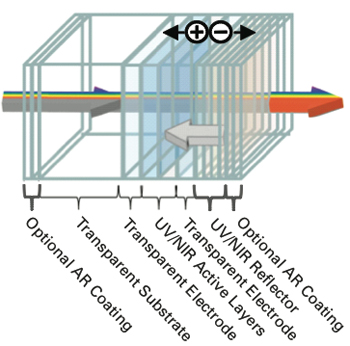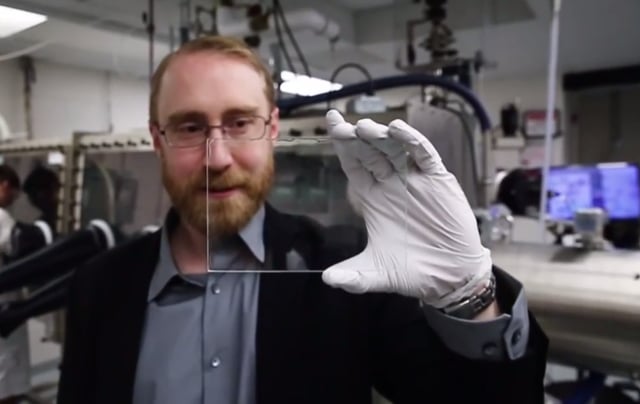By Jean-Jacques DeLisle, contributing writer
A new age for solar energy is at our front door, or more appropriately, our front window. Michigan State University chemical engineering professor Richard Lunt and his team have successfully created a completely transparent solar cell . This see-through form of solar harvesting is expected to propel solar power to the forefront of green energy sometime in the near future.
Solar panels have come a long way since 1839, when Alexandre Edmond Becquerel discovered materials that could produce electricity when exposed to light waves. Three years ago, Richard Lunt and MSU pioneered the idea of see-through solar cells with a transparent film that could be used to cover the windows of houses or other structures.

Diagram of the configuration of the new transparent solar panels. Image source: MSU.
As the production of solar panels continue to rapidly advance, we’ll see new applications for this technology from self-charging phones, solar cells on electric car windows for charging while driving, and even cheaper power bills for residential and commercial buildings. Impressively, the transparent solar panels have the added advantage of reflecting significantly more heat than their predecessors. With reduced temperatures, the solar cells can work more efficiently.

Richard Lunt, the Johansen Crosby Endowed Associate Professor of Chemical Engineering and Materials Science at MSU and Solar Glass. Image source: MSU.
Low-frequency visible light rays, which are just a small portion of the entire electromagnetic spectrum, pass straight through the glass-like solar cells. The non-visible ultraviolet and similar waves are captured by tiny organic molecules in the solar glass, called photovoltaic cells. Using a process similar to photosynthesis, these organic photovoltaic cells collect light energy and transfer this solar harvest to the outer rim of the solar panel. The outer rim is where the captured light is converted to electricity. Abstract organic photovoltaic cells (or OPVs) have emerged as a new competitor to inorganic material-based solar cells due to their potential applications in large-area, portable, and flexible solar panels.
According to Professor Lunt, by harvesting only invisible light, these devices can provide a similar electricity-generation potential as rooftop solar while providing additional functionality. Soon, there may no longer be clunky solar panels that absolutely ruin the appearance of buildings, but they’ll have the same quality. Solar skylights could replace the overbearing, traditional solar panels that are in use today. Allowing people to benefit from this natural light as well as the solar energy will be a boon to humanity. Imagine the touchscreen on your smartphone that’s capable of charging its battery while you’re in sunlight and have no charger handy, or a spaceship with photovoltaic windows that can harvest light from nearby stars. These new solar advancements, coupled with increases in batteries and energy storage, will make solar power more relevant than ever, and it’s not beyond the realm of possibility to expect to see a slew of glass-like solar products in the near future.
Advertisement
Learn more about Electronic Products Magazine





